LisbonLisboaPortugal.com
The best independent guide to Lisbon
LisbonLisboaPortugal.com
The best independent guide to Lisbon
Lisbon in 48 hours; a 2-day itinerary and tour for 2025
Lisbon is a city of remarkable contrasts, where centuries of maritime history meet a dynamic contemporary culture. While a full exploration of the capital could take many days, a focused 48-hour visit offers a superb introduction to its essential character, making it an ideal plan for a weekend city break.
This itinerary guides you through the city’s most significant districts in a logical progression. The first day is an immersion in Lisbon's historic soul, from the grand, orderly plazas of the Baixa district to the ancient, maze-like streets of Alfama. The second day explores the city’s relationship with the water, beginning in Belém, the monumental waterfront that speaks of Portugal’s Age of Discovery, before concluding in the futuristic Parque das Nações.
Designed for the first-time visitor, this guide presents a rewarding and efficient route to experience the best of the city. It provides a complete itinerary for a short stay or can serve as the perfect starting point for an extended tour of Portugal.
Related articles: Introduction to Lisbon - 3 days in Lisbon
An Overview of the 2-day Itinerary
This itinerary is structured to provide a logical and rewarding journey through Lisbon’s most important and contrasting districts. The two days are organised as follows:
• Day 1 Morning: The grand plazas of the Baixa district.
• Day 1 Afternoon: The historic alleys of the Alfama district.
• Day 1 Evening: A choice of sunset views, either from the Graça viewpoint or a Tagus River cruise.
• Day 2 Morning: The maritime heritage of the Belém district.
• Day 2 Afternoon: The modern waterfront of Parque das Nações
• Day 2 Afternoon (alternative): The elegance of Príncipe Real and Avenida da Liberdade
• Day 2 Evening: The vibrant nightlife of the Bairro Alto and Cais do Sodré districts.
An interactive map illustrating this two-day journey is provided below. The route for the first day is marked in green, and the second day is highlighted in blue. You can zoom in on the map to see the specific points of interest and routes for each stage of the tour.
Sights of day one: 1) Praça do Comércio 2) Rua Augusta 3) Elevador de Santa Justa 4) Rossio 5) Praça dos Restauradores 6) Igreja de Santo António 7) Sé Cathedral 8) Castelo de São Jorge 9) Portas do Sol viewpoint 10) Panteão Nacional 11) Time Out Market food market 12) Pink Street
Sights of day two: 13) Mosteiro dos Jerónimos 14) Padrão dos Descobrimentos 15) Torre de Belém 16) Pastéis de Belém 17) Museu Nacional dos Coches 18) Parque das Nações 19) Oceanário de Lisboa 20) Torre Vasco da Gama
Alternatives for day two: 21) Sintra 22) Cascais 23) Praia de Carcavelos beach
Alternative Options for Day 2: Sintra or the Coastline
While this itinerary focuses on the city itself, the second day can easily be substituted with a day trip to the surrounding region. The two most popular choices are the historic town of Sintra or a visit to the charming Lisbon coastline.
A Day Trip to Sintra
Sintra is the most popular day trip from Lisbon, and its historic centre is a designated UNESCO World Heritage site. The town is set within the pine-covered hills of the Serra de Sintra and is famed for the magnificent Palácio da Pena, a vividly coloured Romanticist palace that crowns the region's highest peak. A direct and scenic train service connects Lisbon’s Rossio Station to Sintra, making it a straightforward and highly rewarding excursion - Sintra guide.
A Day on the Coastline
During the summer months, a relaxing day on the coast offers a wonderful alternative to city sightseeing. The Lisbon region is known for its beautiful sandy beaches, which are easily accessible by train. For a classic beach experience, Praia de Carcavelos is the largest and most popular stretch of sand on the coastline. Alternatively, the town of Cascais is a charming former fishing village that has grown into an elegant resort, offering a delightful centre and a series of sheltered, scenic beaches.
For visitors who choose either of these day trips, the route for Day 1 of this itinerary provides the perfect immersion into the heart of historic Lisbon. The city’s other districts, such as Belém and Parque das Nações, can then be saved for a future visit.
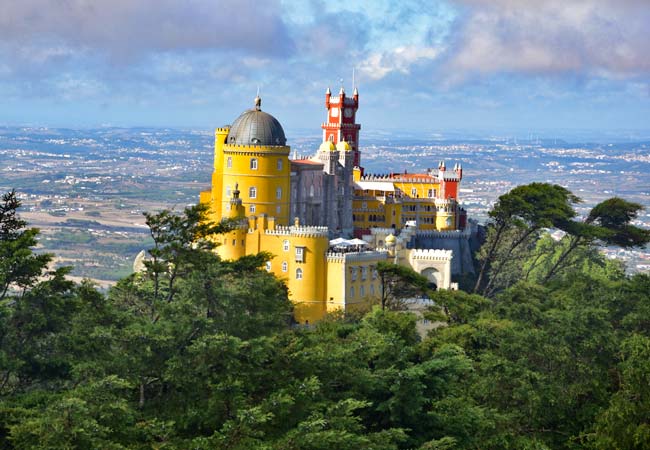
The colourful Palácio Nacional da Pena is one of the finest palaces in Europe
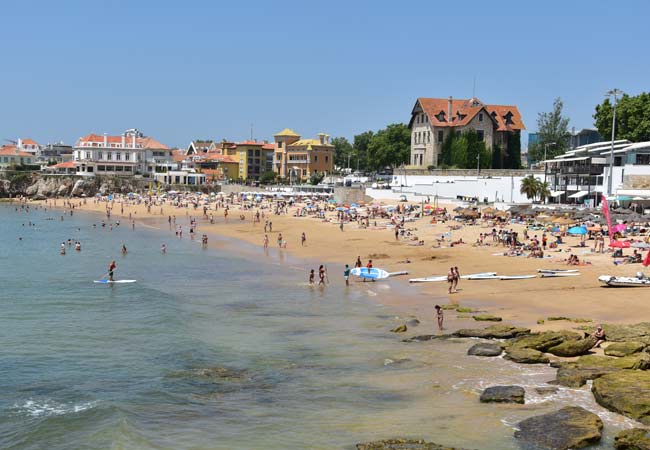
Cascais is a delightful mix of grand 19th-century villas and beautiful sandy beaches
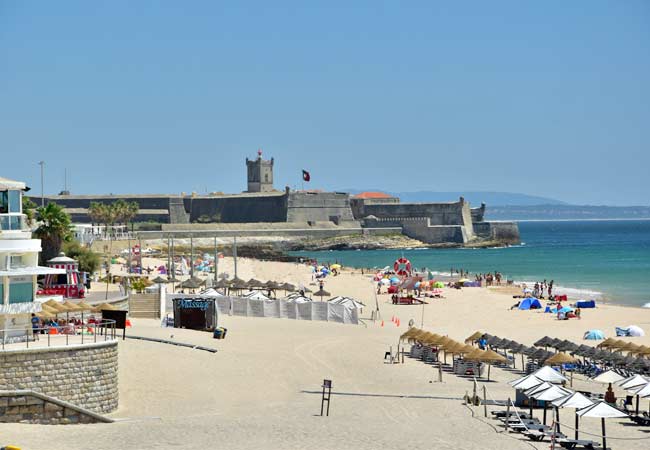
The Praia de Carcavelos is the largest beach of the Lisbon coastline and is served by a train from Lisbon
The following section details the 48-hour tour of Lisbon and provides links to further in-depth guides.
48 hours in Lisbon
Day 1 Morning: The Grand Plazas of Baixa
The first morning of the itinerary explores Baixa, the elegant and orderly heart of Lisbon. The district’s character is a direct result of its history; it was completely destroyed by the great earthquake of 1755 and subsequently rebuilt as one of the world's first grid-plan city layouts. This reconstruction created the grand avenues, spacious squares, and harmonious neoclassical architecture, known as the Pombaline style, that define the area today.
A natural starting point is the monumental Praça do Comércio, the city’s most impressive plaza. Opening onto the Tagus River, this vast, arcaded square served as the historic commercial and maritime gateway to Lisbon. From here, you can pass under the triumphal Arco da Rua Augusta, which leads onto the district's main pedestrian artery. This lively street, the Rua Augusta, is known for its traditional mosaic pavements, outdoor cafés, and high-street shops.
The walk through the district leads north to Rossio Square, a bustling plaza that has been the social heart of Lisbon for centuries, famous for its distinctive wave-patterned cobblestones and bronze fountains. Nearby is another of Baixa’s most famous landmarks, the Elevador de Santa Justa. This ornate, 19th-century iron lift is a marvel of industrial-age engineering, built to connect the lower Baixa with the upper neighbourhood of Chiado.
From the Praça do Comércio, a pleasant walk west along the riverfront promenade of Ribeira das Naus leads towards the adjacent Cais do Sodré district. Here you will find the Time Out Market, a vibrant modern food hall housed in a historic market building. It is an excellent destination for lunch, offering a wide variety of high-quality food from some of Lisbon’s best chefs.
Related articles: Guide to the Baixa district
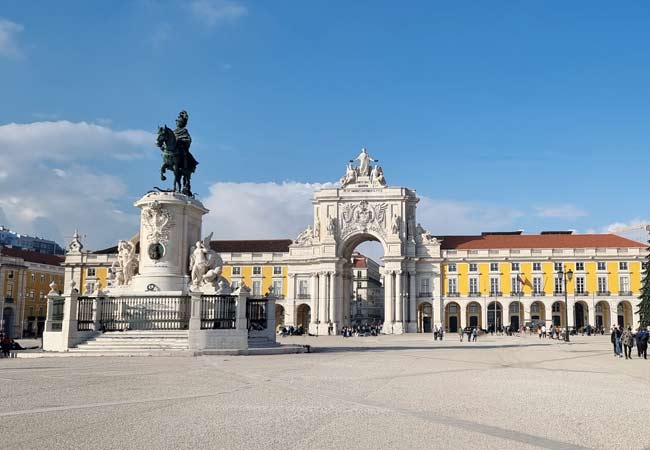
The Praça do Comércio was the historic trading centre of Lisbon
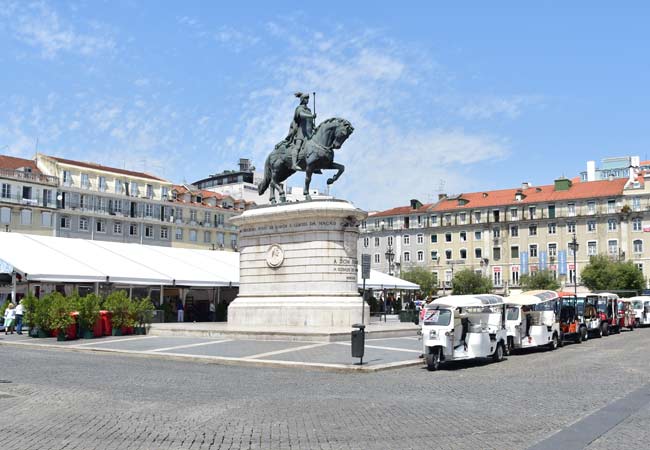
Praça da Figueira is one of the grand plazas in the Baixa district
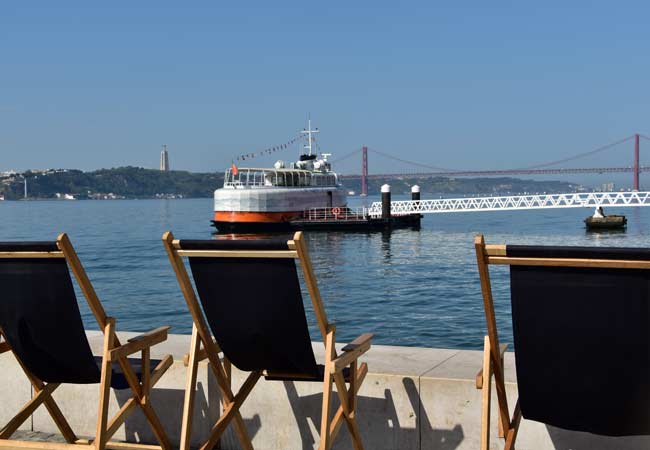
The Ribeira das Naus overlooks the Tejo Estuary
Day 1 Afternoon: The Ancient Alleys of Alfama
The afternoon is dedicated to exploring Alfama, Lisbon’s oldest and most historically significant district. Its character is defined by the fact that it largely survived the 1755 earthquake, preserving its medieval layout of a dense, maze-like web of streets and alleys. This provides a dramatic contrast to the grand, orderly grid of the Baixa district.
Dominating the lower part of the district is the imposing Sé Cathedral. Founded in the 12th century, the city’s oldest building has a heavy, fortress-like Romanesque design with crenellated walls, reflecting its origins during the Christian Reconquest of the city. It stands as a powerful symbol of Lisbon's early history.
Crowning the hill above the district are the ancient ramparts of the Castelo de São Jorge. With origins as a Moorish citadel, this fortress was the seat of power for centuries. A visit allows for an exploration of its fortified walls and keep, and its terrace offers some of the most commanding panoramic views across the city and the Tagus River.
The unique atmosphere of Alfama is also found in its celebrated viewpoints (miradouros). The Miradouro das Portas do Sol provides the classic postcard image of the neighbourhood's red-tiled rooftops, while the nearby Miradouro de Santa Luzia is a charming terrace decorated with traditional azulejo tile panels. The district's identity is further shaped by the iconic yellow number 28 tram, which negotiates the incredibly tight turns of its main streets, and its status as the historic heartland of Fado music.
Related articles: Alfama guide - Tram 28 guide
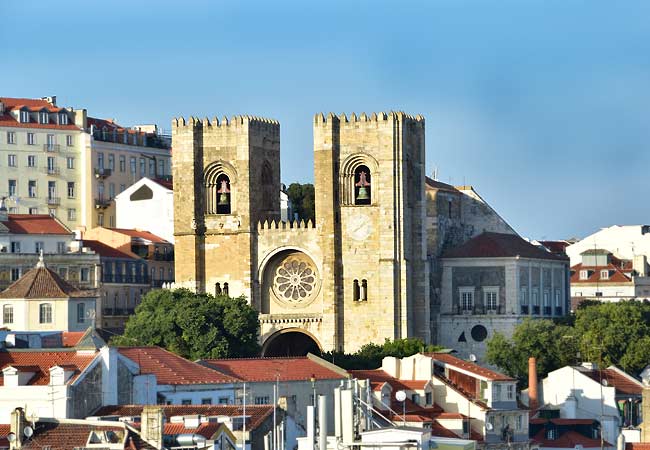
The Sé Cathedral standing high above the Alfama district
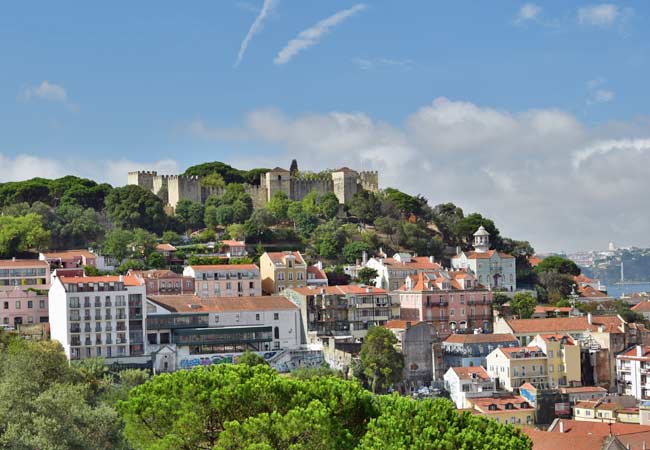
Between 1255 and 1521, the Portuguese nobility ruled over Portugal from Castelo de São Jorge
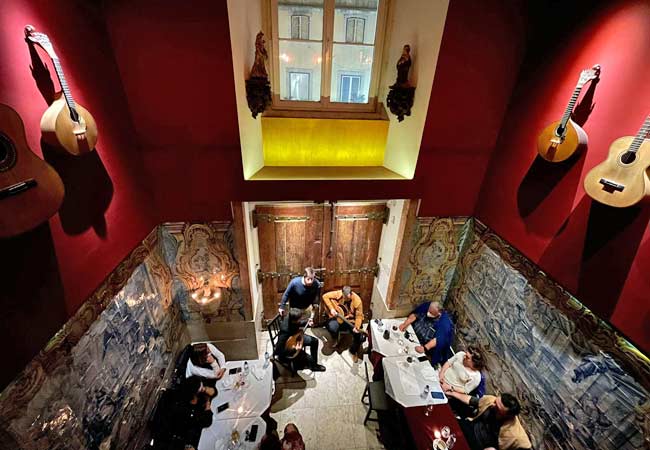
Fado is a stirring and passionate style of music sung by a solo singer and accompanied by a classical Portuguese guitar
Evening: Two Sunset Perspectives
The evening offers a choice between two classic Lisbon sunset experiences: a panoramic hilltop view followed by a traditional meal, or a relaxing cruise along the river.
Alternative 1: Hilltop Views and Dinner in Graça
For an authentic local experience, a short walk from the castle leads into the neighbouring district of Graça. Here, the Miradouro da Graça offers a spectacular vantage point for sunset. From its pine-shaded terrace, you can watch the late afternoon sun illuminate the castle walls and cast a warm glow across the city. This viewpoint is also the perfect introduction to Graça itself, a genuine Lisbon neighbourhood with a proud, unpretentious atmosphere. It is an ideal place to find an authentic neighbourhood tasca for dinner, away from the main tourist crowds.
Alternative 2: A Sunset Cruise on the Tagus River
For a more relaxing perspective, a sunset cruise on the Tagus River offers a memorable end to the day. This provides a completely different view of the city after a day on foot, showcasing the scale of the waterfront as it is bathed in the warm light of the golden hour. The typical two-hour route provides views of Lisbon's most famous landmarks, gliding past the Torre de Belém and the Padrão dos Descobrimentos, sailing beneath the Ponte 25 de Abril bridge, and seeing the Cristo Rei statue. As this is a popular activity, booking in advance is highly recommended, especially during the high season.
Finding Accommodation in Lisbon
Lisbon is a popular destination throughout the year, and demand for accommodation is consistently high, particularly during the peak season. To secure your preferred hotel and the most favourable rates, booking well in advance is strongly recommended.
The map below displays the location of hotels and rental apartments across the city. By entering your travel dates, you can view current availability and pricing to help you find the ideal base for your trip.
Booking.comDay 2 Morning: The Maritime Heritage of Belém
The second day’s itinerary begins in Belém, the grand waterfront district to the west of the city from which Portugal’s 15th and 16th-century navigators departed. This is an area defined by monuments to the Age of Discovery, best reached by the number 15 tram that runs along the river from the city centre.
The undisputed centrepiece of the district is the magnificent Mosteiro dos Jerónimos. A masterpiece of Manueline architecture, its construction was funded by the nation's spice trade. This vast monastery is celebrated for its ornate stonework and houses the tomb of the explorer Vasco da Gama within its impressive church.
Along the waterfront stand two of Lisbon's most famous landmarks. The striking Padrão dos Descobrimentos (Monument to the Discoveries) is shaped like the prow of a ship, honouring the figures who defined this era of exploration.
Further along the riverbank is the elegant Torre de Belém, a fortified 16th-century tower that served as both a defensive structure and a ceremonial gateway to the city.
No visit is complete without tasting the original custard tart from the famed bakery, Pastéis de Belém, which has used its secret recipe since 1837. For those with further interest, the district is also home to major cultural institutions, including the modern art of the Berardo Collection and the remarkable royal carriage collection at the Museu Nacional dos Coches.
Related articles: The Belem district
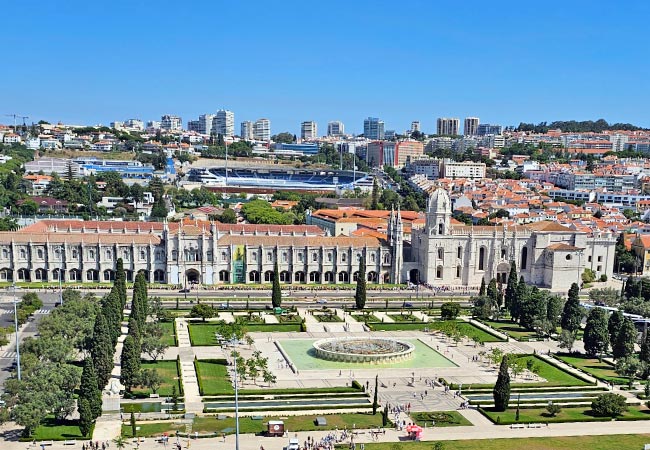
The Mosteiro dos Jerónimos was funded by a 5% tax on the spice trade, and this vast wealth meant the monastery took over 100 years to construct

The Padrão dos Descobrimentos commemorates the 16th century Portuguese explorers
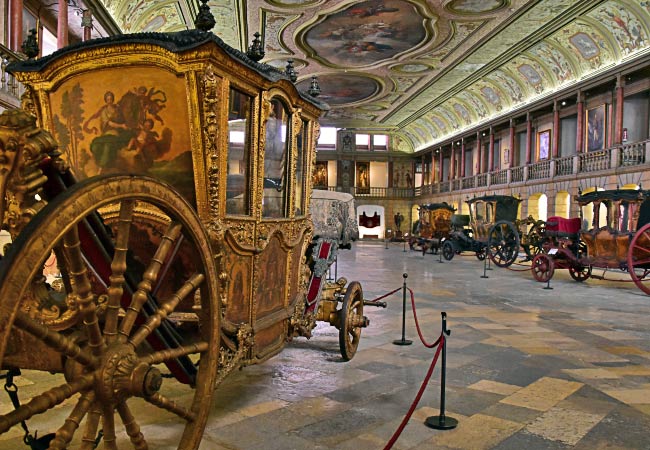
The Museu Nacional dos Coches exhibits a unique collection of horse-drawn carriages
Day 2 Afternoon: The Modern Waterfront of Parque das Nações
The afternoon presents a complete shift in character with a visit to Parque das Nações. This futuristic district on the eastern waterfront was comprehensively redeveloped to host the Expo '98 world fair and now stands as a symbol of modern Lisbon. The area is defined by its bold contemporary architecture, public art, and expansive green spaces along the river. The district is best reached by the metro (Red Line), arriving at the spectacular Gare do Oriente.
Designed by the architect Santiago Calatrava, the station itself is a landmark, with a stunning, skeleton-like canopy arching over the platforms. From here, the district opens up onto wide riverside promenades, water gardens, and spacious parks. The atmosphere is open and calm, offering a different pace from the historic centre.
The principal attraction is the world-class Oceanário de Lisboa, widely considered one of the finest aquariums in Europe. It is celebrated for its huge central tank, which represents the open ocean, surrounded by four separate habitats recreating the diverse ecosystems of different global coastlines.
Beyond the aquarium, the district offers a range of other attractions. A ride on the Teleférico de Lisboa (cable car) provides excellent aerial views as it glides along the Tagus riverfront. Nearby, the Pavilhão do Conhecimento is an engaging interactive science museum, ideal for families. The skyline is marked by the soaring, sail-shaped Torre Vasco da Gama, Lisbon’s tallest building, while the large Vasco da Gama Shopping Centre offers a vast range of retail and dining options. With its calm atmosphere and numerous indoor activities, Parque das Nações is an especially rewarding destination on a hot day, offering a relaxing and engaging conclusion to your explorations.
Related articles: The Parque das Nações
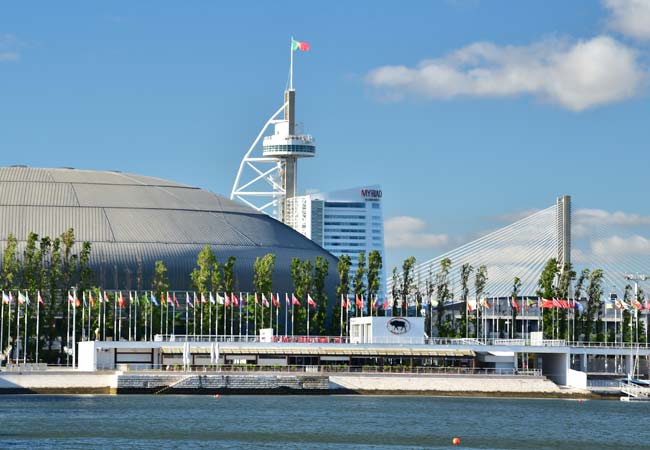
The theme for Expo'98 was the world's oceans
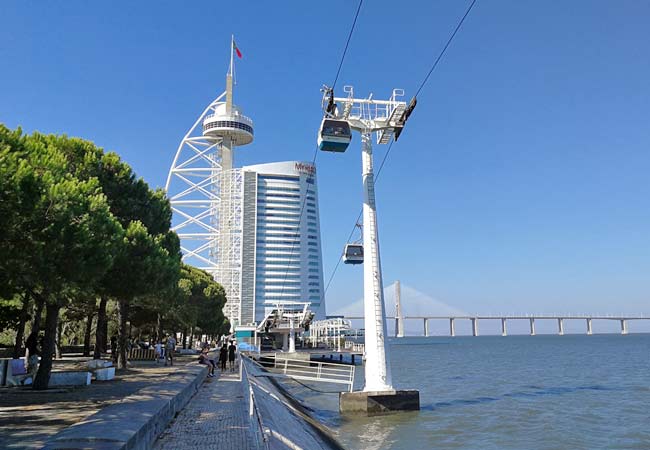
The Torre Vasco da Gama is the tallest building in Lisbon, and the cable car runs along the length of the Parque das Nações
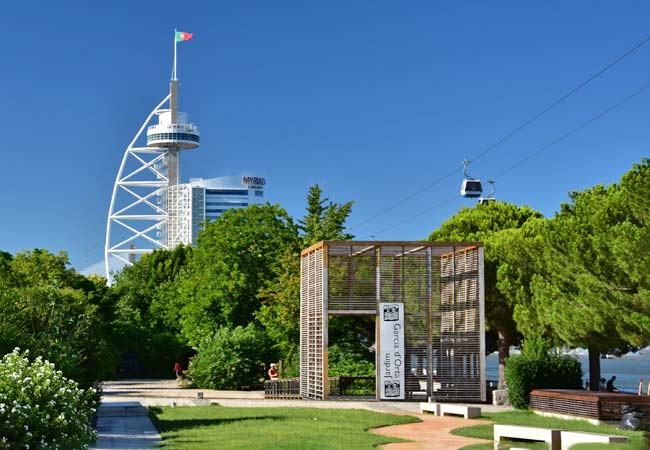
The Garcia de Orta garden in the Parque das Nações
Alternative Afternoon: Elegant Boulevards and Príncipe Real
For an afternoon focused on Lisbon's sophisticated 19th-century character, a walk through the Príncipe Real district and the grand Avenida da Liberdade offers a wonderful contrast to the modernity of Parque das Nações. This alternative route explores the city's most elegant boulevards, gardens, and viewpoints.
The exploration could begin at the top of the Avenida da Liberdade, Lisbon’s most exclusive boulevard. This wide, tree-lined promenade with its intricate mosaic pavements is home to designer stores, international boutiques, and grand hotels. At its northern end is the large roundabout of Praça Marquês de Pombal, which marks the entrance to Parque Eduardo VII. From the top of these manicured gardens, you are rewarded with a magnificent formal view down the length of the avenue towards the Tagus River.
Adjacent to the upper sections of the avenue lies Príncipe Real, one of Lisbon’s most refined residential districts. The area is known for its grand 19th-century mansions, many of which now house independent boutiques, concept stores, and antique shops. The heart of the neighbourhood is the Jardim do Príncipe Real, a charming garden shaded by a magnificent, sprawling cedar tree. A highlight is the Embaixada, a stunning 19th-century neo-Moorish palace transformed into an innovative shopping gallery for local designers. The walk through the district culminates at the Miradouro de São Pedro de Alcântara. This terraced viewpoint offers one of the city's most celebrated panoramas, looking directly across to the Castelo de São Jorge and the historic hills of Alfama.
Related articles: Príncipe Real guide
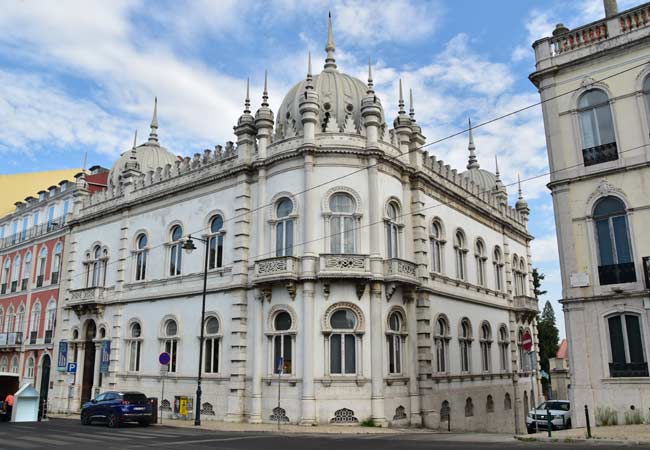
The grand buildings in Príncipe Real
Evening: The Nightlife of Bairro Alto and Cais do Sodré
As evening arrives, Lisbon’s nightlife begins in the historic hilltop district of Bairro Alto. By day a quiet residential area, the neighbourhood undergoes a nightly transformation. The district is a maze of narrow cobbled streets, where a diverse crowd gathers in a mix of venues that cater to all styles, from trendy cocktail bars to traditional houses where the melancholic sound of Fado music can be heard. Especially on weekends, the lively atmosphere spills outside, with the entire area becoming a vibrant, open-air social gathering.
The energy in Bairro Alto typically lasts until around 2 am. From there, the night continues in the district of Cais do Sodré, located a short walk downhill towards the river. Once the city's notorious red-light district, it has been completely reinvented as Lisbon's late-night hub. The centre of the action is Rua Nova do Carvalho, famously painted a vivid pink and now known simply as Pink Street. This is where you will find many of the city’s most popular music venues and clubs, keeping the energy going well into the early hours of the morning.
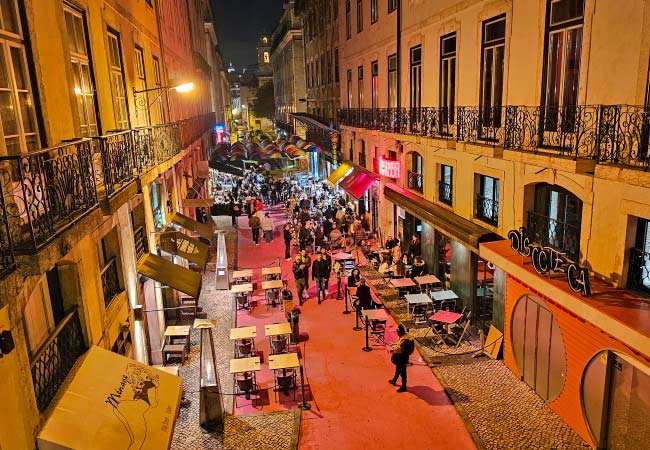
Pink Street
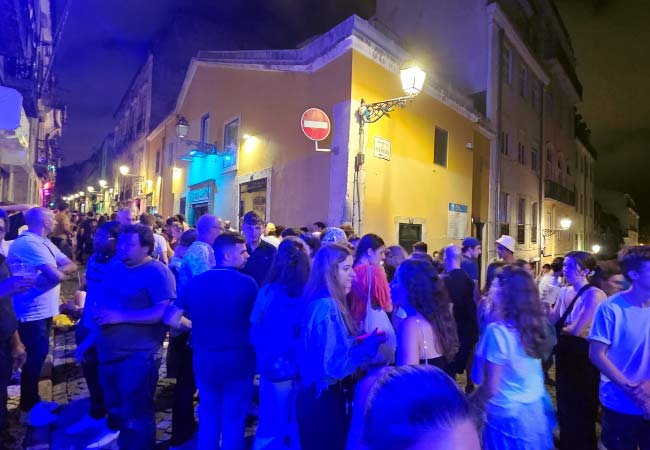
The socialising spills into the streets on a Friday night in Bairro Alto
Discover more of Lisbon with our most popular guides
If you've found our content valuable, we'd welcome your support.
The digital publishing landscape has evolved significantly. As a small independent publisher, we face growing challenges. Search engines increasingly favour paid content over organic results, while AI-generated content often reproduces original work without attribution.
To support our work, please consider bookmarking this page (press Ctrl + D) for quick access. If you find an article helpful, we'd be grateful if you'd share it with friends on social media.
For specific questions, please see our Reddit community at r/LisbonPortugalTravel.
Should you notice any outdated or incorrect information, please contact us at [email protected]
Thank you for helping us continue to provide valuable content in an increasingly challenging digital environment.
A complete list of all of our Lisbon articles
If you've found our content valuable, we'd welcome your support.
The digital publishing landscape has evolved significantly. As a small independent publisher, we face growing challenges. Search engines increasingly favour paid content over organic results, while AI-generated content often reproduces original work without attribution.
To support our work, please consider bookmarking this page (press Ctrl + D) for quick access. If you find an article helpful, we'd be grateful if you'd share it with friends on social media.
For specific questions, please see our Reddit community at r/LisbonPortugalTravel.
Should you notice any outdated or incorrect information, please contact us at [email protected]
Thank you for helping us continue to provide valuable content in an increasingly challenging digital environment.



































